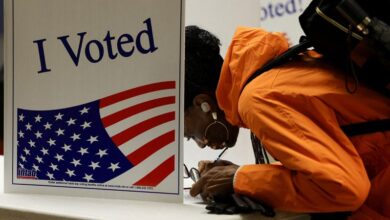Trump’s next move on the election’s biggest loser

The biggest loser on election night was the supreme leader of Iran, Ali Khamenei. The Tehran regime has spent years plotting Donald Trump’s assassination, only to see him return to the Oval Office with greater popular support than ever.
Trump knows that he had Khamenei on the ropes when his first term ended. ‘Iran was broke under Donald Trump,’ the 45th president said in the lone presidential debate this fall. In addition, a drone strike eliminated Iranian terror chief Qassem Soleimani in January 2020.
Now it is time for Trump to bring back his policy of maximum pressure, which shook the regime to its core. And Trump should add a second pillar to his strategy: maximum support for the Iranian people, who still thirst for freedom.
As president, Biden has squandered the leverage he inherited from Trump. Biden eased up on sanctions, hoping to persuade Tehran to curb its nuclear program. Instead, the regime pocketed tens of billions of dollars from loosened restrictions on its oil exports and raced toward a nuclear weapons capability. Today, Iran possesses enough enriched uranium to produce material for up to 15 nuclear weapons within five months.
Tehran also continued to fund, train, and equip terrorist organizations across the Middle East, including Hamas, Hezbollah, and Yemen’s Houthis. On October 7 last year, Iran celebrated the massacre that its support made possible.
During Trump’s first term, his administration took nearly two years to settle on a consistent Iran policy and impose tough sanctions. This meant if Khamenei could endure just two years of maximum pressure, Americans might turn Trump out of office. The gamble paid off.
This time around, Trump should ensure that Tehran has to endure four full years of unstinting pressure. The regime is wealthier thanks to Biden – its petroleum exports tripled after Trump left office, generating $144 billion of sales from 2021 through 2023. But Tehran is reeling from the hammer blows Israel has delivered to the regime and its proxies since the October 7 slaughter. Twice, Iran has attempted to strike Israel with barrages of missiles, rockets, and drones, all to little effect. Yet when Israel hit back on October 25, it demonstrated that Iran’s supposedly robust air defenses were nearly worthless.
If the Israelis could operate with impunity in Iranian skies, the U.S. Air Force and Navy would face even less resistance. If Trump clearly and consistently says the United States will employ every means at its disposal to prevent Iran from building a nuclear weapon, the threat of force will be credible. Khamenei will know that if he sprints for the bomb, it may spell the end of his regime. Biden claimed he would never let Iran get a nuclear weapon, but the threat was hollow.
Trump’s sanctions framework from his first term mostly remains in place; his administration only needs to enforce it and strengthen it further. This should include the reintroduction of secondary sanctions against nations that illegally purchase Iranian oil, targeting their banks, shipping companies, and other intermediaries involved.
Trump should also push to ‘snap back’ United Nations sanctions on Iran, restoring international prohibitions against its military, missile, and nuclear programs. A key priority should be enlisting France, Germany, and the United Kingdom to renew these sanctions before the snap back option expires in October 2025.
To support the Iranian people, Trump should consider leveraging Elon Musk’s Starlink technology to provide internet access in Iran. This would help Iranians to communicate, bypass regime censorship, and organize. Washington could also establish a support fund for the opposition, akin to the one it established for Poland’s Solidarity Movement in the 1980s. Even without American support, waves of mass protest have spread across Iran multiple times since 2017, but the regime prevailed by gunning down peaceful demonstrators.
Khamenei may seek to defuse the pressure he faces by allowing his government to restart nuclear negotiations. In Europe and the United States, President Masoud Pezeshkian, enjoys an unearned reputation as a moderate despite his complete loyalty to Khamenei. Wanting to believe Tehran was serious about resolving its differences at the negotiation, Biden fell for a similar ruse.
Trump must refuse to negotiate unless Tehran is prepared to stop enriching uranium, dismantle its military nuclear program, and end all support for terrorism. Iran would also have to guarantee complete access for the International Atomic Energy Agency to monitor the deal’s implementation — deficient inspections were one of the fatal flaws of Barack Obama’s 2015 nuclear deal.
Trump now has an opportunity to help the Iranian people end the Islamic Republic and curb the regime’s nuclear ambitions. Aiding in the liberation of Iran and deterring its nuclear development could cement Trump’s legacy as a pivotal figure in achieving peace and stability in the Middle East—an accomplishment worthy of a Nobel Peace Prize.
Andrea Stricker is deputy director of the Nonproliferation and Biodefense Program and a research fellow at FDD, a nonpartisan research institute focusing on national security and foreign policy.




